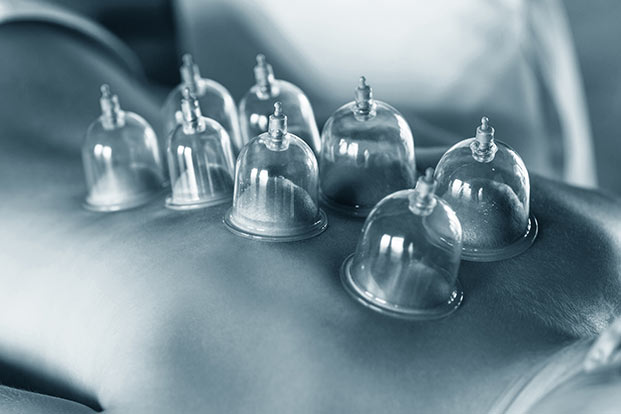Cupping is an alternative medicine therapy that uses glass, earthenware or bamboo cups affixed to the skin to achieve healing. The idea is to draw out the cause of various ailments using suction. Such celebrities as Jennifer Aniston and Gwyneth Paltrow have been public advocates for cupping’s benefits.
The practice is ancient. Cupping is believed to date back to 3,000 B.C., when it was used in Egypt. One of the oldest surviving medical textbooks in the world, the Ebers Papyrus, describes cupping practices dating to 1,550 B.C. There is also evidence of cupping being used in China as far back as 1,000 B.C., while in Greece, Hippocrates used cupping during his life, circa 400 B.C. From there, the practice spread throughout Asia, Europe and the Middle East.
At least in Europe, cupping was believed to be derived from humoral medicine, a system that the ancient Greeks developed to deal with what they believed were the four humors of the body — blood, yellow bile, black bile and phlegm. Cupping was believed to draw irritations and other problems from the body, which ancient people believed entered the body and caused pain and other ailments. Healers often used oral suction methods to draw out these influences, which were often believed by superstitious people to be the work of evil spirits.
Oral suction eventually gave way to the use of various primitive implements, including shells and animal horns, to achieve cupping. In North America, Native Americans are believed to have used the tip of buffalo horns to practice cupping. Suction was created by putting the tip of the horn on the body and sucking out the air through the tip. Bone tips were also used to achieve the effect.
Hippocrates, known as the father of modern medicine and the man who came up with the credo that today’s physicians recite, the Hippocratic oath, followed a course of seeking natural explanations for illness. He rejected evil spirits, intervention by the gods and other beliefs. Hippocrates and his followers instead believed that diet, insufficient exercise, exposure to bad weather, a lack of balance in life and emotional problems were the source of most incidents of bad health. They used cupping to treat menstrual problems, angina and other disorders.
Dry and Wet Cupping
Although he did not invent it, Hippocrates wrote about two forms of cupping, known as dry cupping and wet cupping (sometimes moist cupping).
Dry cupping yanks the tissue under the cup up into the area of the cup. With wet cupping, the skin is cut to produce blood flow, and then the cup is applied. When suction is achieved, the blood flow increases.
To achieve a seal and create the right conditions for suction, substances like herbs, alcohol or paper are placed on the skin and set on fire. As the fire dies, the practitioner places the cup upside down on the skin. When the air cools, a vacuum seal is created, causing a rise in the skin and reddening of the cupped area. This takes anywhere from five to 10 minutes.
In modern times, a rubber pump is used to create the vacuum rather than a flame, and the cups themselves are usually made of silicone. This allows the practitioner to manipulate and massage the area.
Wet cupping practices draw up the skin and blood. Then a small scalpel creates small incisions so that a second suction can draw out the blood. The cuts are then treated with standard antibiotics and bandages as a safeguard against infection.
Modern cupping sessions, both wet and dry, last up to 15 minutes.
Later in history, such famous doctors as Galen, Ambroise Pare and Paracelsus practiced cupping. In Europe, barbers who practiced surgery and bath house workers were also skilled in the art.
The Benefits of Cupping
Cupping advocates believe the practice can increase blood flow, thereby promoting healing in a range of ailments. While traditional Western medicine remains skeptical that cupping does much of anything, a 2012 study by the medical journal PLoS ONE claimed that cupping, in combination with acupuncture and medications, could be effective in treating such varied diseases as herpes zoster, acne, facial paralysis and cervical spondylosis. Australian and Chinese researchers took their information from 134 studies published between 1992 and 2010 on cupping.
Modern Advocates
While cupping is regarded skeptically in many traditional medicine areas, its advocates take on a quasi-religious fervor in its support.
The British Cupping Society is an organization that promotes cupping. It claims that cupping practices can treat such diverse ailments as blood disorders, fertility issues, high blood pressure, bronchial congestion, varicose veins, migraines and arthritis. It is also advocated for fibromyalgia, hemophilia, anemia and asthma. The society claims it is a great way to reduce pain and inflammation and promotes a general sense of well-being.
The British Cupping Society does admit that burns, bruises and skin infections may result from cupping but say skilled health professionals can minimize such effects. Still, they don’t advocate its use for pregnant women, advanced metastatic cancer treatments, bone fractures, deep vein thrombosis, ulcers, arteries and any other areas where a pulse can be felt. Most of the areas that the society suggests be left alone are delicate, and cupping could potentially disturb the areas or rupture critical vessels.
One of the biggest drawbacks of cupping is that some people forego traditional medicine in favor of it. No less than the American Cancer Society has warned that relying on cupping and delaying conventional treatment can have serious consequences. There is also an issue with traditional medicine practitioners taking the marks cupping leaves as signs of abuse.
If you decide to explore cupping, it’s wise to advise your traditional doctor that you are exploring this alternative medicine. That way, you will have the benefit of traditional advice and whatever benefits can be accrued from this non-traditional method.

Leave a Reply